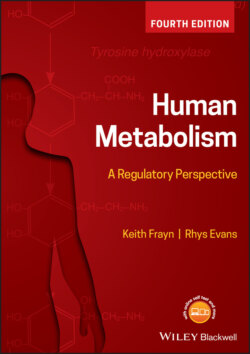Читать книгу Human Metabolism - Keith N. Frayn - Страница 37
1.3.2.1.4 Pyruvate oxidation
ОглавлениеPyruvate can also enter mitochondria where it is a substrate for the enzyme PDH (PDH is actually a complex of three enzymes, sometimes called pyruvate dehydrogenase complex, PDC). PDC not only further oxidises pyruvate, but also removes one carbon, resulting in the formation of (2 carbon) acetyl-CoA which, as described earlier, can be fully oxidised in the TCA cycle. This reaction is essentially irreversible. The importance of this process is illustrated by looking at the energy yield of these pathways: glycolysis yields 2 ATPs by substrate-level phosphorylation, but much energy remains within the pyruvate molecule; full oxidation of pyruvate, via formation of acetyl-CoA and oxidation in the TCA cycle, yields a further 36 ATPs. This number is a theoretical maximum and allowing for some inefficiency the real figure is probably slightly lower than this, but it illustrates how much energy can be derived from oxidation, and hence how important mitochondria (TCA cycle, electron transport chain) are for producing ATP.
Breakdown of glucose as far as acetyl-CoA can also be part of a synthetic process. Acetyl-CoA produced from glucose is the starting point for the pathways of lipid synthesis: lipogenesis, which usually refers to the synthesis of fatty acids from glucose, and cholesterol synthesis. These pathways, like most biosynthetic pathways, are cytosolic, and the acetyl-CoA must be transferred out of the mitochondria (to be expanded later – Box 5.4).
